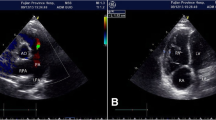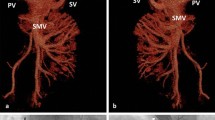Abstract
We report a 25-year-old man who presented with congenital absence of the portal vein, or Abernethy malformation, a rare congenital disorder in which the mesenteric and splenic venous drainages bypass the liver and directly drain into the inferior vena cava through an extrahepatic portosystemic shunt. Magnetic resonance imaging, which showed multiple nodular lesions in both liver lobes that were associated with an absence of intrahepatic portal venous branches, strongly suggested the diagnosis of the Abernethy malformation. Carbon dioxide wedged venography and transvenous liver biopsy, which were performed in the same session by a right jugular approach, confirmed these findings. This technique can be considered a valuable alternative diagnostic tool to catheter arteriography and percutaneous transhepatic liver biopsy.




Similar content being viewed by others
References
Badler R, Price AP, Moy L, Katz DS. Congenital portacaval shunt: CT demonstration. Pediatr Radiol 2002;32:28–30
Niwa T, Aida N, Tachibana K, et al. Congenital absence of the portal vein: clinical and radiologic findings. J Comput Assist Tomogr 2002;26:681–686
Pichon N, Maisonnette F, Pichon-Lefièvre F, et al. Hepatocarcinoma with congenital agenesis of the portal vein. JJCO 2003;33:314–316
Kohda E, Saeki M, Nakano M, et al. Congenital absence of the portal vein in a boy. Pediatr Radiol 1999;29:235–237
Tanaka Y, Takayanagi M, Shiratori Y, et al. Congenital absence of portal vein with multiple hyperplastic nodular lesions in the liver. J Gastroenterol 2003;38:288–294
Morgan G, Superina R. Congenital absence of the portal vein and a proposed classification for portosystemic vascular anomalies. J Pediatr Surg 1994;29:1239–1241
Abernethy J. Account of two instances of uncommon formation in the viscera of the human body. Phil Trans R Soc Lond B Biol Sci 1793;83:295–299
Murray CP, Yoo S-J, Babyn PS. Congenital extrahepatic portosystemic shunts. Pediatr Radiol 2003;33:614–620
Marks C. Development of the portal venous system. Am J Surg 1969;117:671–681
Massin M, Verloes A, Jamblin P. Cardiac anomalies associated with congenital absence of the portal vein. Cardiol Young 1999;9:522–525
Kanamori Y, Hashizume K, Kitano Y, et al. Congenital extrahepatic portocaval shunt (Abernethy type 2), huge liver mass, and patent ductus arteriosus—a case report of its rare clinical presentation in a young girl. J Pediatr Surg 2003;38:E15
Karrer FM, Hall RJ, Lilly JR. Biliary atresia and the polysplenia syndrome. J Pediatr Surg 1991;26:524–527
Altavilla G, Guariso G. Focal nodular hyperplasia of the liver associated with portal vein agenesis: a morphological and immunohistochemical study of one case and review of the literature. Adv Clin Pathol 1999;3:139–145
Motoori S, Shinozaki M, Goto N, Kondo F. Congenital absence of the portal vein associated with nodular hyperplasia in the liver. J Gastroenterol Hepatol 1997;12:639–643
Matsuoka Y, Ohtomo K, Okubo T, et al. Congenital absence of the portal vein. Gastrointest Radiol 1992;17:31–33
DeGaetano AM, Gui B, Macis G, et al. Congenital absence of the portal vein associated with focal nodular hyperplasia in the liver in an adult woman: imaging and review of the literature. Abdom Imaging 2004;29:455–459
Bellah RD, Hayek J, Teele RL (1989) Anomalous portal venous connection to the suprahepatic vena cava: sonographic demonstration. Pediatr Radiol 20:115–117
Debernardi-Venon W, Bandi J-C, Garcia-Pagan J-C, et al. CO2 wedged hepatic venography in the evaluation of portal hypertension. Gut 2000;46:856–860
Krajina A, Lojik M, Chovanec V, et al. Wedged hepatic venography for targeting the portal vein during TIPS: comparison of carbon dioxide and iodinated contrast agents. Cardiovasc Intervent Radiol 2002;25:171–175
Martinez-Cuesta A, Elduayen B, Vivas I, et al. CO2 wedged hepatic venography: technical considerations and comparison with direct and indirect portography with iodinated contrast. Abdom Imaging 2000;25:576–582
Shinkai M, Ohhama Y, Nishi T, et al. Congenital absence of the portal vein and role of liver transplantation in children. J Pediatr Surg 2001;36:1026–1031
Ikeda S, Sera Y, Ohshiro H, et al. Surgical indications for patients with hyperammonemia. J Pediatr Surg 1999;34:1012–1015
Author information
Authors and Affiliations
Rights and permissions
About this article
Cite this article
Collard, B., Maleux, G., Heye, S. et al. Value of carbon dioxide wedged venography and transvenous liver biopsy in the definitive diagnosis of Abernethy malformation. Abdom Imaging 31, 315–319 (2006). https://doi.org/10.1007/s00261-005-0151-9
Received:
Accepted:
Published:
Issue Date:
DOI: https://doi.org/10.1007/s00261-005-0151-9




